Digital Poster
Cerebrovascular Methods
ISMRM & ISMRT Annual Meeting & Exhibition • 10-15 May 2025 • Honolulu, Hawai'i

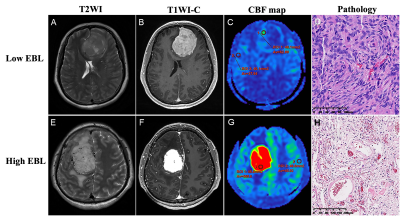 |
Computer Number: 49
2309. Can
cerebral flow estimated from 3D pCASL predict intraoperative
blood loss in non-embolized meningioma? A feasibility study
X. Deng, L. Lv, D. Luo, Y. Xiao, J. Dai, Q. Wen, X. Xiao
The Second Affiliated Hospital, Jiangxi Medical College, Nanchang University, Nanchang, China
Impact: The rCBF and VRTB may serve as promising
non-invasive imaging biomarkers to preoperatively predict
EBL and guide meningioma surgery planning.
|
|
 |
Computer Number: 50
2310. Direct
Revascularization Reduces Arterial Transit Time in Moyamoya
Patients
M. Zhao, M. Moseley, G. Steinberg
Stanford University, Stanford, United States
Impact: ASL can be utilized to evaluate transit time in
Moyamoya patients before and after direct revascularization.
|
|
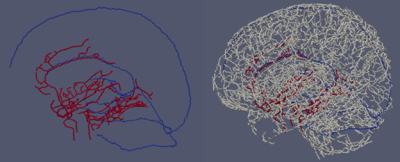 |
Computer Number: 51
2311. Validating
Kinetic Perfusion Parameter Mapping Using a High-Fidelity Whole
Brain Simulation
B. Weppner, Q. Zhang, D. Romano, R. Hu, I. Kovanlikaya, P.
Spincemaille, Y. Wang
Cornell University, Ithaca, United States
Impact: We demonstrate a detailed in-silico perfusion
model that allows the investigate the accuracy of perfusion
modeling methods.
|
|
 |
Computer Number: 52
2312. Associations
between retinal microvasculature, ocular blood flow, and
cerebral blood flow in healthy adults
Q. Wu, S. Dolui, J. Wang, H. Jiang, J. Morgan, M. Taso, G.
Aguirre, J. Detre
University of Pennsylvania, Philadelphia, United States
Impact: Observed
structural and functional associations in retinal
vasculature support the notion of the eye as a window to
brain perfusion.
|
|
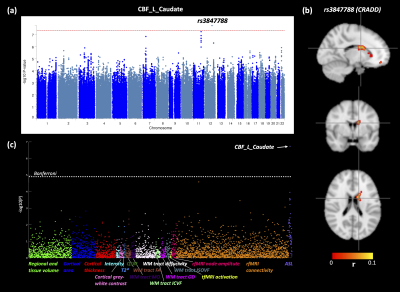 |
Computer Number: 53
2313. Phenotypic
and Genetic Insights into Brain Perfusion Using Arterial Spin
Labeling in UK Biobank
X. Xu, A. Martins-Bach, L. Elliott, F. Alfaro-Almagro, G.
Douaud, S. Lee, C. Tisca, M. Li, S. Smith, K. Miller, D. Wu,
T. Okell
University of Oxford, Oxford, United Kingdom
Impact: This study highlights ASL-derived measures as
valuable indicators of brain health, linking them to
lifestyle, cardiovascular, and genetic factors. ASL's
potential for population-level monitoring offers insights
for early detection and intervention strategies in
neurological health, improving patient outcomes.
|
|
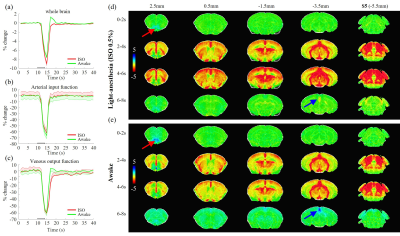 |
Computer Number: 54
2314. Perfusion-related
BOLD fMRI to transient hypoxic stimuli in awake vs. anesthetized
mice
G. H. Im, S. Choi, T. Thi Le, S-G Kim
Institute for Basic Science, Yuseong-gu, Korea, Republic of
Impact: We identified differences in cerebral
perfusion-related properties between awake and anesthetized
conditions in normal mice. Our findings indicate that our
awake perfusion imaging approach can be applied to
neurodegenerative disease models.
|
|
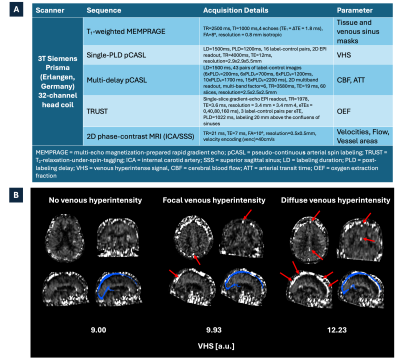 |
Computer Number: 55
2315. Characterizing
venous hyperintense signal on ASL MRI as a marker of reduced
oxygen extraction efficiency in older adults
J. Kufer, G. Gassner, J. Jacoby, K. Maina, N. Mercaldo, D.
Salat, M. Juttukonda
Massachusetts General Hospital, Charlestown, United States
Impact: VHS
may serve as a distinct marker of reduced oxygen extraction
efficiency in older adults and could facilitate deeper
insights into contributions of capillary dysfunction to
age-related pathologies such as white matter lesions or
neurodegeneration, especially in APOE ε4 carriers.
|
|
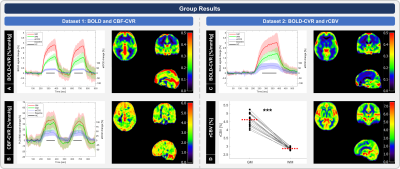 |
Computer Number: 56
2316. Dynamic
Susceptibility Contrast MRI and Arterial Spin Labeling reveals
blood volume dependence of BOLD-based Cerebrovascular Reactivity
G. Hoffmann, L. Schmitzer, J. Kufer, F. Richter, C. Zimmer,
J. Göttler, S. Kaczmarz, C. Preibisch
Technical University of Munich, Munich, Germany
Impact:
BOLD-CVR, a promising marker of vascular health, may be biased by CBV. Using pCASL-CBF and DSC-rCBV data and simulations, we revealed the dependency of BOLD-CVR on rCBV. Therefore, CBV should be considered when interpreting CVR assessments, especially in diagnostic applications. |
|
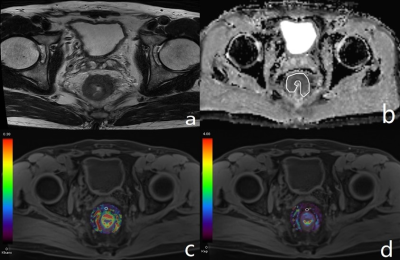 |
Computer Number: 57
2317. Employing
Golden-Angle Radial Sparse Parallel MRI in Rectal Perfusion to
Predict Extramural Venous Invasion in Rectal Cancer
M. Zhou, M. Chen
Sichuan Orthopaedic Hospita, Chengdu, China
Impact: Integrating GRASP-enhanced MRI with ADC values
can lead to more accurate and reliable preoperative
assessment of pEMVI in rectal cancer, aiding clinicians in
treatment planning and potentially improving patient
outcomes.
|
|
 |
Computer Number: 58
2318. Wavelet-Based
Time-Frequency Analysis of Radiation-Induced Vascular Changes in
Brain Tumors Using Dynamic Contrast Enhanced MRI
H. Bagher-Ebadian, S. Brown, M. Ghassemi, P. Acharya, J.
Ewing, I. Chetty, F. Siddiqui, B. Movsas, K. Thind
Henry Ford Health, Detroit, United States
Impact: This study presents a novel DCE-MRI-based
approach using Nested-Model-Selection and wavelet analysis
to identify radiation-induced changes in animal models of
brain tumor and normal tissues, offering potential clinical
applications in improving and optimizing radiation treatment
planning for brain cancer patients.
|
|
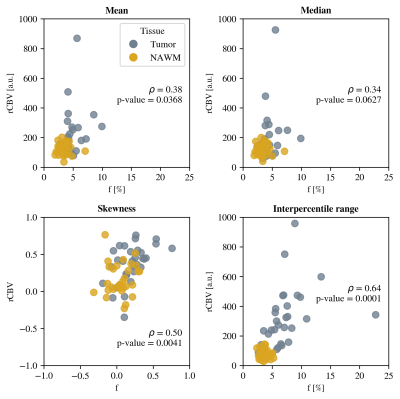 |
Computer Number: 59
2319. Quantitative
Analysis of IVIM and DSC Perfusion Metrics in Brain Tumors
L. Rosenqvist, O. Jalnefjord, M. Laesser, A. Blombäck, A.
Jakola, I. Björkman-Burtscher, M. Ljungberg
University of Gothenburg, Gothenburg, Sweden
Impact:
The interpercentile range of f and rCBV captured a homogeneous perfusion estimation in normal-appearing white matter and demonstrated heterogenously increased perfusion in tumor tissue. The choice of statistical ROI measure can impact the clinical interpretation of quantitative perfusion metrics. |
|
 |
Computer Number: 60
2320. Arterial
spin labelling MRI predicts diagnostic label and progression on
ADNI-3 data
A. Bodossian, L. Zhang, A. Dell’Ariccia, T. Kirk, M. Craig,
M. Chappell
Quantified Imaging, London, United Kingdom
Impact: CBF-based classifiers using ASL-MRI offer a
promising non-invasive approach to early AD diagnosis and
tracking disease progression. It could add value to the
current neuroimaging and fluid-based biomarkers.
|
|
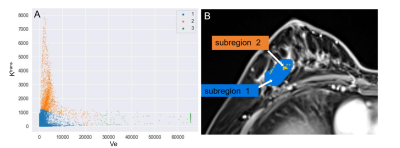 |
Computer Number: 61
2321. Tumor-infiltrating
lymphocytes evaluation using quantitative DCE-MRI-based habitat
imaging in breast cancer patients: a preliminary study
Z. Mao, Q. Wang, P. Sun, H. Liu, H. Liu
The Fourth Hospital of Hebei Medical University, Shijiazhuang 050011, China
Impact: This study indicates that quantitative DCE-based
habitat imaging holds potential for the assessment of TILs
in breast cancer.
|
|
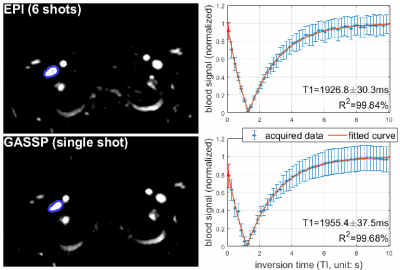 |
Computer Number: 62
2322. Ultrafast
blood T1 measurement at the internal jugular vein using Golden
Angle rotated Spiral k-t Sparse Parallel imaging (GASSP)
D. Zhu, Z. Xu, Q. Qin
Kennedy Krieger Institute, Baltimore, United States
Impact: This study showed that the ultrafast (~10s)
blood T1 measurement
at the internal jugular vein with 1mm2 in-plane
resolution using Golden Angle rotated Spiral k-t Sparse
Parallel imaging (GASSP) yielded comparable performance with
EPI and high intra-scan reproducibility.
|
|
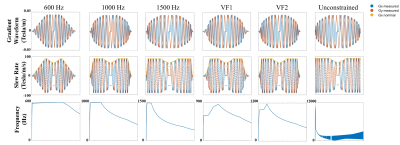 |
Computer Number: 63
2323. Frequency-constrained
Numerical Spiral Trajectory Algrithm for improving dual echo
spiral MRI.
Y. Cao, J. Zhao, W. Liu, Q. Zeng, W. Tang, H. Wang
CAS Center for Excellence in Nanoscience, National Center for Nanoscience and Technology, Beijing, China
Impact: This method enhances dual-echo spiral MRI for
DCE and DSC perfusion imaging, improving image quality and
acquisition speed in clinical settings. It enables more
accurate assessments of conditions like stroke and cancer,
and could broaden the use of spiral MRI.
|
|
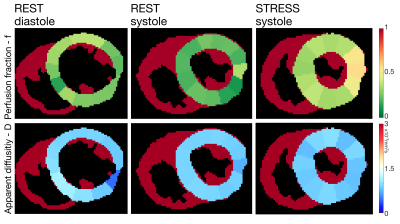 |
Computer Number: 64
2324. Simultaneous
non-contrast assessment of myocardial microstructure and
perfusion in multiple cardiac phases at stress and rest
E. J. Lim, C. Munoz, B. Hammad, N. Aye, S. Hashimoto, R.
Wage, K. Kunze, D. Pennell, S. Nielles-Vallespin, A. Scott
Imperial College London, London, United Kingdom
Impact: STEAM-IVIM holds great potential for future
studies in patient cohorts, delivering simultaneous
intrinsically co-registered assessment of inducible ischemia
and microstructure, providing new insights into the
microstructural and microvascular underpinnings of heart
diseases.
|
The International Society for Magnetic Resonance in Medicine is accredited by the Accreditation Council for Continuing Medical Education to provide continuing medical education for physicians.